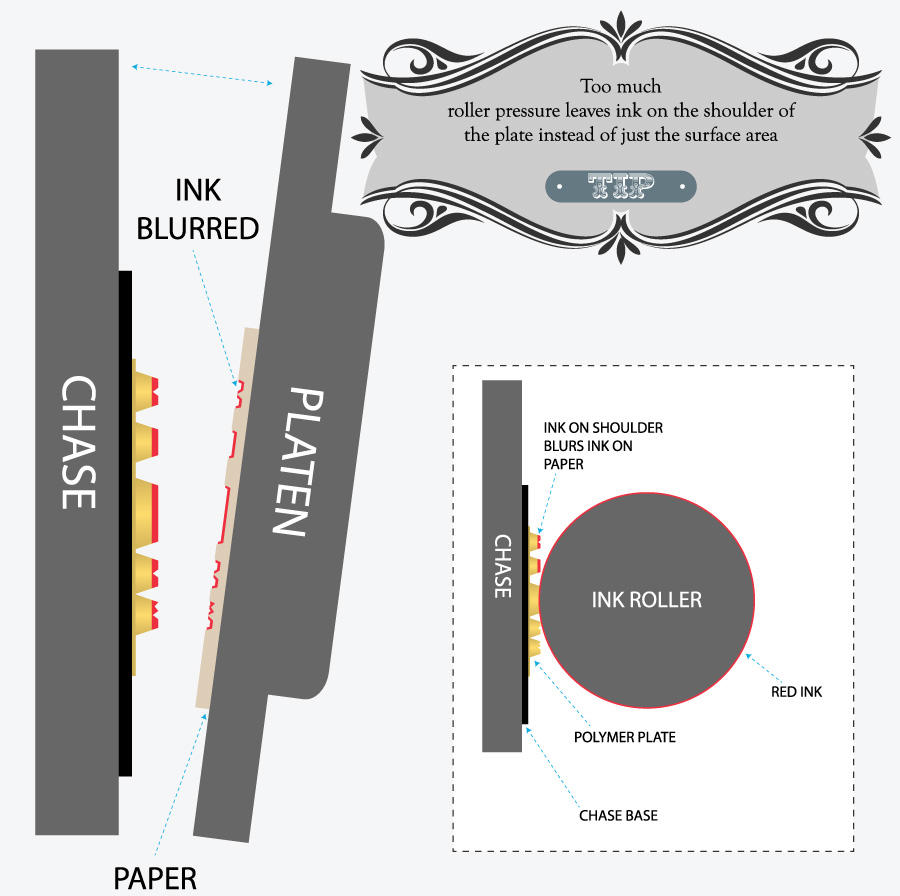
Precision Type High Roller Gauge – for Letterpress Platens
The Lyme Bay Press Precision Roller Gauge allows letterpress printers to accurately set the height of the inking rollers on a platen press. Remove the chase and ink up the press then place the roller gauge flat against the rear casting where the chase would normally sit. This allows for a near perfect print first time when using a combination of The Chase Base and our polymer printing plates for letterpress.
Carefully turn the flywheel of the press until the ink rollers pass gently over the round disc of the gauge ensuring the gauge remains still and flat. Wind the rollers back down and remove the gauge and examine it.
A thin stripe of ink will have appeared, this stripe should not be more than approx 2.5mm if it is the rollers need raising by adding packing to the inking rails, a length of tape may suffice. Repeat the test and keep adding packing until the stripe is the correct thickness. The tolerance for ink is very tight, the better this procedure is performed the better your inking will be!
Click here to go to our store….

Roller Height – The Key To Great Inking
This subject is probably the most important issue you’ll read about. Getting inking right makes the difference between a quality job and a disaster. Roller height determines the pressure applied to the type or plate surface, too much will squash ink down the shoulder of the plate or beard of the type while too little pressure may mean ink is very light or has areas missing from the impression; if rollers are too high from the surface to be printed your plate or type may not ink at all.

Clearly then the first step is to remove all packing or cover strips from your ink rails, ink up the press and use your roller gauge to check the roller height. Using a roller gauge is covered in the relevant article in the forum. If you don’t have a roller gauge then you can try the following method.
Step 1
Pull an impression and decide what action is required.
Q Are you inking the plate?
If you are not, your rollers are too high. If your press has mechanical adjustment then you need to lower your roller height to minimum setting. If you have or if you have removed all packing and strips from your ink rails and still there’s no ink on your plate then you need to check if you are using the right plate for the right base. If you are using the right plate and base or you are using lead type which you know is in good condition and type high, the only other problem you could have is roller and truck size.
Q Are you under inking the plate?
If you have ink on the plate but the ink is producing a faint print (assuming you have sufficient impression applied) then your roller height needs reducing. All of the above applies then and again you are left with roller and truck issues.
Q Are you over inking the plate?
This should be your problem if you have no packing, cover strips on adjustment applied to your roller height. Looking at your print you should be able to quickly tell how badly you are over inking. Many clamshell presses were meant to have leather ‘bearers’ or cover strips and if you don’t have these your rollers will be too low by a good 2mm or so. If you have existing ones they probably are worn or if they are replacements may be an uneven material. Your best solution is to use the cover strips we provide which are 15 mm strips cut from a lithographic impression blanket 750 mm long and 1.95 mm thick. This material is very durable and stable under pressure and work well with rollers. Without these strips ink rollers on a clamshell press and some other presses will be too low by a significant amount.

Step 2
Assuming then you either don’t need these strips for your press, or you have fitted them; if you are over inking only small adjustments should be required. Apply some clear plastic packing tape to your ink rails, one piece to each side. Clean your plate and re-ink then pull another impression. Decide how close you are to good ink. If still over inking apply another piece to each rail and repeat this step.
Step 3
If you reach the point where ink becomes faint on one side of the plate then remove a layer of tape from that side. Don’t expect both sides to be the same, often these machines are as old as your granny and wear may not be even (that may apply to granny too). You should now be pretty close to good ink, exactly what passes as good ink is covered in another article.
If your roller and trucks are in good condition then you really should be able to achieve nice crisp ink and having reached the final step of this guide that’s where you should be. If you aren’t then please feel free to drop us a line and we’ll see if we can help.
